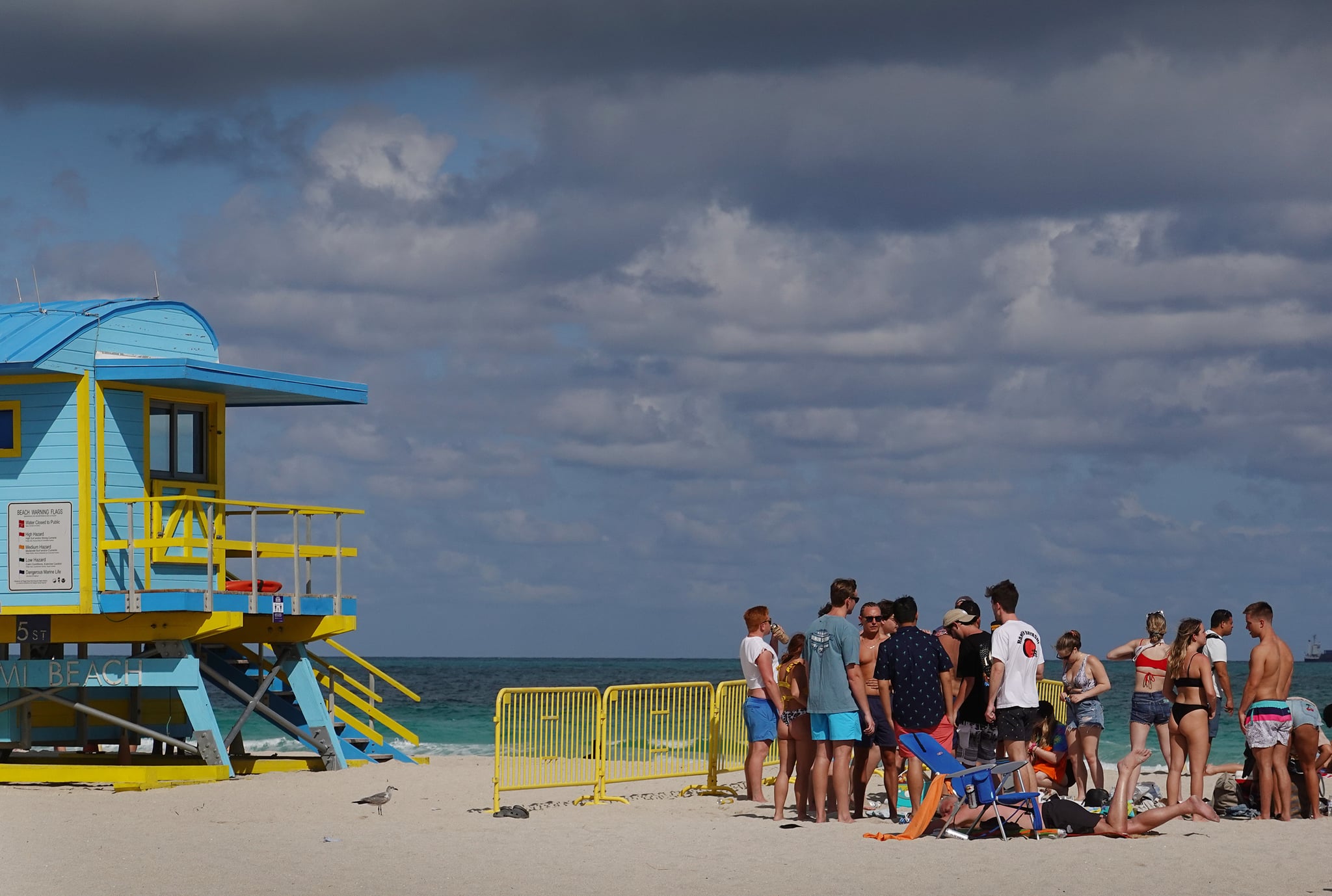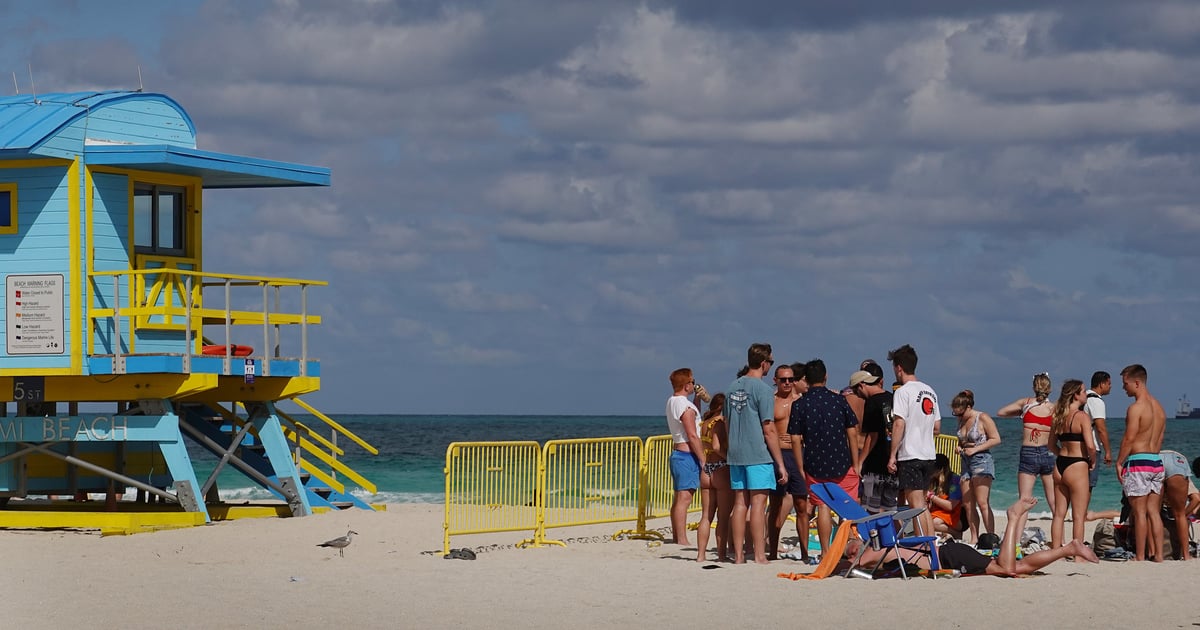
You learn as a kid that if something is deemed wrong, you probably shouldn’t do it. But the more you’re denied it, the more (oh, the more) you want it. Sometimes you grow impatient and take what you shouldn’t even if you’re warned not to — like snagging a chocolate chunk cookie out of the cookie jar when your parents explicitly say you have to wait until after dinner. Now, let me direct your attention to the sandy shores of Miami Beach, because that seems to be the gist of what’s happening there.
If you feel like you’re having deja vu, you’re not alone. We don’t know how many people came back from spring break with coronavirus this time last year (people weren’t ordered to stay home in Florida until April 1, 2020), but we do know, for instance, that cases as far away as California and Massachusetts were attributed to Miami Beach’s Winter Party Festival last March. Now, after a devastating year of sickness, hundreds of thousands of deaths, stay-at-home orders, and isolation from loved ones, young people from across the country, many without masks, are flocking to party despite the fact that we are nowhere near herd immunity.
On March 20, 2021, the city of Miami Beach imposed a curfew and declared a state of emergency to help control the crowds. Both have since been extended, possibly through April 13 if need be. (To make matters worse, the police presence and subsequent arrests in the area has been criticized by the Miami-Dade chapter of the NAACP as racist for primarily targeting Black young people.)
The difference in this 2021 scenario is that we’re a year into a deadly pandemic and we know the consequences of this kind of behavior. However, Governor Ron DeSantis has proved to be lackadaisical about COVID-19 restrictions in the state for a long time now, fully lifting restrictions on restaurants and other businesses in September. So, before the emergency curfew, there really was nothing stopping these spring breakers from feeling like they could “let loose in ways that are unacceptable,” as Miami Beach Mayor Dan Gelber put it. (After all, DeSantis called the state an “oasis of freedom” from restrictions last month at Orlando’s Conservative Political Action Conference.) Not even the fact that an estimated eight percent of COVID-19 cases in Florida are due to the more-contagious B.1.1.7 variant. The only thing that could have stopped them was a sense of moral responsibility (guess that didn’t do the trick either). The cookie jar was left unattended.
I’m four years out of college, but as a twenty-something, I am still a young person. And I’m sick to my stomach seeing social media flooded with footage of people — swarms of young people — living their lives on spring break as if we’re not still in the thick of a global pandemic. It’s not just in Miami either, as my own Snapchat and Instagram feeds suggest.
Take South Padre Island in Texas, where college students are in full-on spring break mode seemingly without safety protocols. One party-goer interviewed by a local news station admits that someone bringing COVID-19 back to school with them is “probably going to happen.” They added, “Like just realistically speaking it probably will happen, but I’m not really concerned, I’m just trying to have fun while I can, you know what I mean?” Another acknowledges their concern with giving the virus to grandparents back home, only to offer a solution: stay there the whole year. For context, Texas Governor Greg Abbott lifted the mask mandate and opened up the state to full capacity earlier this month. My question to spring breakers is, how can you do this with a clear conscience?
In a recent interview, Sabrina Assoumou, MD, MPH, an infectious diseases physician at the Boston Medical Center and an assistant professor at Boston University’s School of Medicine, told me she wants people to remember one thing: though declining, COVID-19 remains a serious threat. “I can still remember when I was in service during the surge in the spring in Boston. I would get these calls about patients who were literally crashing and dying on us,” she recalled. “Every story is someone’s loved one. And COVID is a big deal. There’s so many lives that have been lost.”
I would like to take this opportunity to refresh everyone on a few key facts:
- Superspreader events can lead to mass cases of COVID-19.
- Though young people are less likely to develop severe forms of COVID-19, and more likely to get mild cases, they are not immune to the virus (and BIPOC have been hit the hardest).
- Young people are spreading the virus the most (one study cites Americans between 20 and 49 as being responsible for more than 70 percent of COVID-19 spread last year).
- The COVID-19 vaccines are effective in preventing severe cases of COVID-19 and hospitalizations — and although there is promising data out of Israel suggesting the Pfizer vaccine specifically reduces transmission, we are not 100 percent certain that a vaccinated person can’t still get an asymptomatic case of COVID-19 and transfer the virus.
- Even still, only one in six adults in the US have gotten vaccinated so far. We are a ways away from herd immunity.
- The CDC says that only vaccinated people can now gather in groups without masks, and the agency still says to avoid public crowds.
I can guarantee you, then, that the swarms of twenty-somethings in bikinis, bellies full of cheap beer and Tequila shots, have not all gotten the vaccine (in most parts of the country, older adults, high-risk people, and health care and essential workers are the majority of those who are currently eligible for the COVID-19 vaccines authorized for emergency use in the US). I’m not saying that young people as a whole are acting irresponsibly — did you personally go on spring break in a responsible way? Good for you! — but when hoards of us are being reckless for the world to see, it’s hard to ignore. And, what about when these mask-less and sun-soaked partiers leave? What happens when they go back to their respective houses where they’re doing online learning, or back to their college campuses? What happens then? It’s about the safety of family members, friends, people in public they’ll interact with if they aren’t quarantining.
I’m pleading with fellow young people: hang tight. You want to know what came after the influenza pandemic of 1918? The roaring ’20s. Case in point: we can have our turn to celebrate when the time comes. Until then, drink responsibility in every sense of the word; you don’t have to get together in social-distance-breaking crowds sans masks to have a good time, and that goes for any gathering outside of spring break festivities. Seriously, call up some friends and . . . I don’t know . . . drink in a spaced-out backyard or, better yet, take shots via Zoom!
Does everyone have a right to make their own decisions even if those decisions are dangerous? Sure. Am I, myself, getting antsy? Absolutely. But, my stance is this: don’t take unnecessary risks for a few days of fun in the sun. My general mentality, also, is that if you’re on the fence about whether or not a certain social gathering is safe, don’t go. I may be just one young person — one voice in a sea of ever-changing scientific data and noise and opinions — but this pandemic, spring breakers aside, has shown me people’s true colors, and I’m enraged. Needless to say, if you haven’t already gathered mask-less in large groups, and you haven’t taken the cookie out of the f*cking cookie jar, good on you. I’m right there with you.
